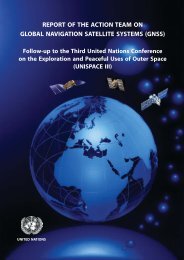Proceedings of the Workshop - United Nations Office for Outer ...
Proceedings of the Workshop - United Nations Office for Outer ...
Proceedings of the Workshop - United Nations Office for Outer ...
- No tags were found...
Create successful ePaper yourself
Turn your PDF publications into a flip-book with our unique Google optimized e-Paper software.
116 EXPANDING GLOBAL REMOTE SENSING SERVICESThere isn't a specific delineation between "military"and "civil" in a manner directly analogous to U.S. lawin many national laws <strong>of</strong> European nations. However,<strong>the</strong> purpose <strong>of</strong> <strong>the</strong> European Space Agency is legallylimited to "exclusively peaceful purposes" by <strong>the</strong>multilateral convention that established it and hasgenerally been interpreted to prohibit militaryactivity.137 EUMETSAT itself has no military mandatealthough <strong>the</strong> EUMETSAT Convention does not contain<strong>the</strong> same "peaceful purposes" language as <strong>the</strong> ESAConvention.In European remote sensing activities, a militarycivilconnection is recognized through "[<strong>the</strong>] FrenchSPOT programme [which] has led to <strong>the</strong> development<strong>of</strong> <strong>the</strong> HELIOS military observation satelliteprogramme in which France has been joined by Italyand Spain."138 European civil-military relationships inremote sensing are complicated by <strong>the</strong> fact thatEUMETSAT members are national meteorologicalservices (NMSs) and some <strong>of</strong> <strong>the</strong>m are funded by, orhave liaison relationships with, national defenseministries. An additional level <strong>of</strong> complexity arises from<strong>the</strong> fact that all European members <strong>of</strong> <strong>the</strong> NorthAtlantic Treaty Organization (NATO) areEUMETSAT members, although not all EUMETSATmembers are in NATO. It is reasonable to expect that<strong>the</strong>se relationships will come to bear in sensitivesecurity decisions involving IJPS and JPS data.It is also necessary to consider <strong>the</strong> IJPS and JPSwithin <strong>the</strong> future ESA-EUMETSAT relationship, <strong>the</strong>interplay <strong>of</strong> <strong>the</strong> limitations contained in <strong>the</strong> ESAConvention under various EUMETSAT-ESAagreements,139 <strong>the</strong> on-going work <strong>of</strong> ESA's Long-137 Convention For The Establishment Of A European SpaceAgency, Ref. CSE CS(73)19, rev. 7, 30 May 1975, Article II138 Commission <strong>of</strong> <strong>the</strong> European Communities, The EuropeanCommunity Crossroads In Space" Report by an Advisory PanelOn The European Community and Space, number CD-NA-10410-EN-C, at 27, (1991), [hereinafter, Crossroads).139 These agreements are listed only as possible examples.They were listed in o<strong>the</strong>r sources as possible agreements <strong>for</strong>review. They were unavailable to <strong>the</strong> author at time <strong>of</strong> writing,so <strong>the</strong>ir applicability has not been verified.ESA/LEG/ 96(R) Agreement between ESA andEUMETSAT on <strong>the</strong> Meteosat operational programme. SignedTerm Space Policy Committee,140 and ESA's post-2000Earth Observation Strategy. The post-2000 EarthObservation Strategy is premised on <strong>the</strong> growingimportance <strong>of</strong> Earth observation data <strong>for</strong> "political" and"geopolitical purposes,"141 <strong>the</strong> "increasing strategicimportance <strong>of</strong> Earth Observation from space [and] aneed <strong>for</strong> a coordinated approach between <strong>the</strong> Europeanplayers...[including] EUMETSAT."142 The internationalcoordination necessary to implement <strong>the</strong> strategycoordinating <strong>the</strong> ESA program with national programs,harmonizing missions and data usage, and"streng<strong>the</strong>ning] cooperation with...EUMETSAT"143provides fertile ground <strong>for</strong> legal queries regardingappropriate military-civil relations. The importance <strong>of</strong><strong>the</strong> ESA Convention in <strong>the</strong> future <strong>of</strong> an integratedEuropean space agenda was acknowledged by <strong>the</strong>Advisory Panel on <strong>the</strong> European Community and Spacewhen it recommended that, "<strong>the</strong> facilities and expertise<strong>of</strong> ESA [must] be made available as far as possible inon 12.1.1987 and entered into <strong>for</strong>ce with retroactive effect from1.1.1987.ESA/LEG/115(R) Supplementary Agreement between <strong>the</strong>European Organisation <strong>for</strong> <strong>the</strong> Exploitation <strong>of</strong> MeteorologicalSatellites (EUMETSAT) and <strong>the</strong> European Space Agencyconcerning <strong>the</strong> Meteosat Operational programme. Signed on 1February 1989. Entered into <strong>for</strong>ce same date (see alsoESA/LEG/96).ESA/LEG/ 166(R) Agreement between EUMETSAT andESA concerning <strong>the</strong> Meteosat Second Generation System.Signed in Paris on 17 February 1994. Entered into <strong>for</strong>ce on <strong>the</strong>date <strong>of</strong> signature.ESA/LEG/ 200 Agreement between EUMETSAT and ESAconcerning <strong>the</strong> MSG, Second and Third Satellites. Signed on 16October 1996 and entered into <strong>for</strong>ce on <strong>the</strong> date <strong>of</strong> signature.140 Bonnefoy. R. and Arend, H., ESA's Earth-ObservationStrategy, ESA Bulletin Number 85. February, (1996),[hereinafter. Strategy].http://esapub.esrin.esa.it/bulletin/bullet85/arend85.htm. PressRelease - M inisters Shape The Future O f European SpaceActivities European Space Agency, Number 17-99 - Paris, 12May 1999.141 Strategy, supra note 140.142 Id.143 Id.
















